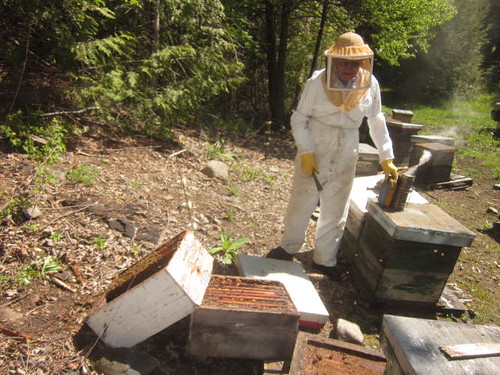Ontario Beekeepers Prize Pungent Buckwheat Honey
 After spending time with another local beekeeper and helping harvest his annual summer honey crop this son of a beekeeper has become even more acutely aware of the various honey regions that are waiting to be discovered by North American kitchens , across the province of Ontario.
After spending time with another local beekeeper and helping harvest his annual summer honey crop this son of a beekeeper has become even more acutely aware of the various honey regions that are waiting to be discovered by North American kitchens , across the province of Ontario.
One such naturally occurring region is the wild buckwheat fields in northeastern Ontario, above hwy 7 on…
ContinueAdded by Robert Campbell on September 1, 2012 at 3:00pm — 1 Comment
New Holland 658, Baling Hay in Ontario Canada
Talk about 'making hay while the sun shines'. Here's a short video I shot on Saturday June 16th 2012 of my nephew Ryan baling hay with his New Holland 658 hay baler. The grass feed is a mixture of alfalfa, red clover and timothy and as such will make excellent feed for the growing numbers of cows on their feedlots.
I can remember harvesting the hay in this field in the 1970s and 80s - we used to walk behind the tractor and wagon and pitch 80 lbs bales onto the wagon…
ContinueAdded by Robert Campbell on June 17, 2012 at 2:36am — No Comments
Black Bears Strike But Are Repelled By Electric Fences In Ontario Beeyards
Some black bears did launch an attack on of our remote beeyards last week!
This is what bear damage looks like, and it could have been a lot worse. The total loss was only four frames of brood. And that's because this beeyard, like all of our locations in southern Ontario, is protected by a heavy duty solar fencer.
Its unlikely the hive blew over in the wind - in the…
ContinueAdded by Robert Campbell on May 13, 2012 at 1:49pm — 1 Comment
Son of a Beekeeper Blog on Ontario Agriculture Network
 Hello from Rob Campbell the original Son of a Beekeeper in Ontario Canada.
Hello from Rob Campbell the original Son of a Beekeeper in Ontario Canada.
I hope to keep a blog presence here on the Ontario Agricultural network to keep readers updated on the latest challenges facing Canadian beekeepers. Because I have the good fortune of living near and helping out my family's…
ContinueAdded by Robert Campbell on April 15, 2012 at 4:50am — 1 Comment
Latest Blog Posts
Most Popular Blog Posts
© 2026 Created by Darren Marsland.
Powered by
![]()
